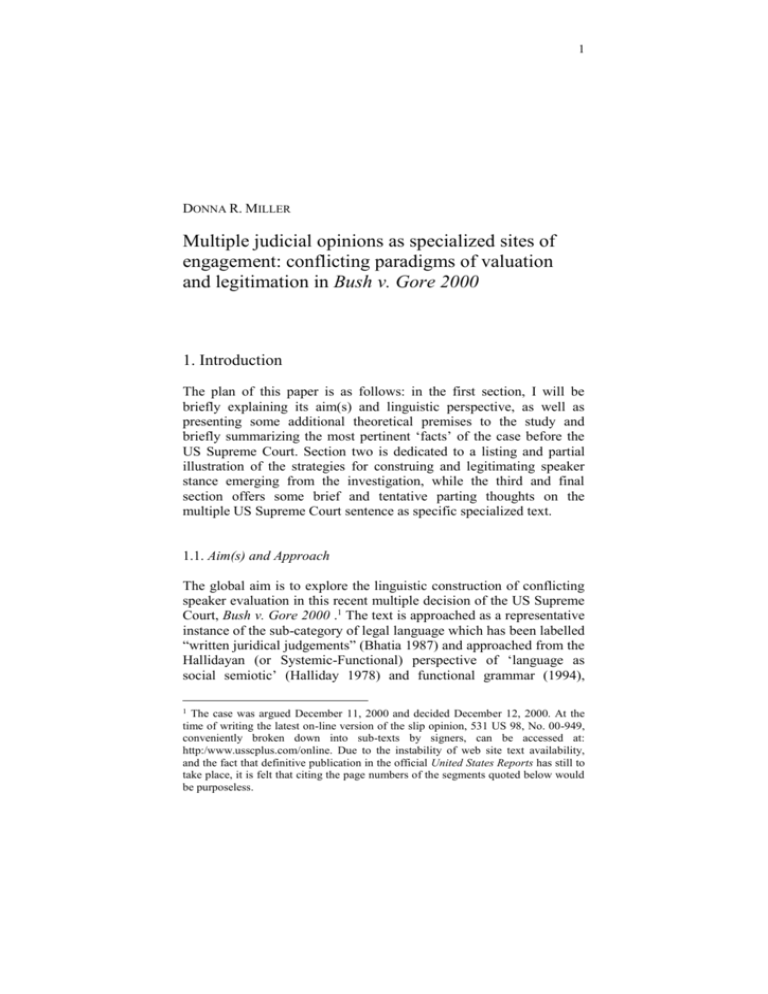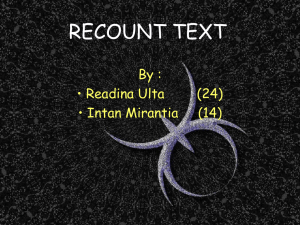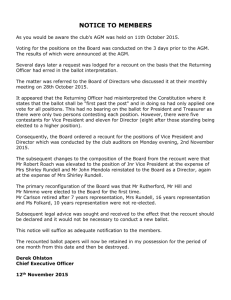DONNA R - Appraisal Theory Homepage
advertisement

1 DONNA R. MILLER Multiple judicial opinions as specialized sites of engagement: conflicting paradigms of valuation and legitimation in Bush v. Gore 2000 1. Introduction The plan of this paper is as follows: in the first section, I will be briefly explaining its aim(s) and linguistic perspective, as well as presenting some additional theoretical premises to the study and briefly summarizing the most pertinent ‘facts’ of the case before the US Supreme Court. Section two is dedicated to a listing and partial illustration of the strategies for construing and legitimating speaker stance emerging from the investigation, while the third and final section offers some brief and tentative parting thoughts on the multiple US Supreme Court sentence as specific specialized text. 1.1. Aim(s) and Approach The global aim is to explore the linguistic construction of conflicting speaker evaluation in this recent multiple decision of the US Supreme Court, Bush v. Gore 2000 .1 The text is approached as a representative instance of the sub-category of legal language which has been labelled “written juridical judgements” (Bhatia 1987) and approached from the Hallidayan (or Systemic-Functional) perspective of ‘language as social semiotic’ (Halliday 1978) and functional grammar (1994), 1 The case was argued December 11, 2000 and decided December 12, 2000. At the time of writing the latest on-line version of the slip opinion, 531 US 98, No. 00-949, conveniently broken down into sub-texts by signers, can be accessed at: http:/www.usscplus.com/online. Due to the instability of web site text availability, and the fact that definitive publication in the official United States Reports has still to take place, it is felt that citing the page numbers of the segments quoted below would be purposeless. 2 which posit grammar (meaning lexicogrammar) as no less than a theory of human experience, as well as a principle for social action (Halliday 1992: 65). More specifically, according to this descriptive / analytical model, ways of saying (lexicogrammar) realize meanings (semantic metafunctions), which are determined by specific social situations (contexts), these levels combining to construe particular functional varieties of texts (registers), which also establish meaning relationships across a ‘set’ of texts to which they may be said to ‘belong’ (inter-textuality). In the extant case, moreover, the particular, if heterogeneous, context of culture of the USA will be presumed as the given higher-order semiotic within which this process of text creation takes place (Miller, forthcoming). As the title announces, the paper concentrates on this one text as an instance of a “specialized site of engagement”, one in which conflict and negotiation are typically construed by speaker selections from the semantic resources which the culture makes available for use in struggles for meaning ascendancy. In the framework, these are traditionally thought to be MOOD, MODALITY and Attitudinal Lexis, but the latter two have recently been brought together in the still ongoing, and thus still in flux, modelling of what are called APPRAISAL SYSTEMS (Martin 2000; White 2001; Miller in press; submitted) – which obviously cannot be adequately explained within the confines of this paper.2 The essential point, however, is that Appraisal Theory is concerned with the language of speaker evaluation, attitude and emotion, i.e., with those wordings in and by which speakers negotiate and ‘naturalize’ subjective, and ultimately ideological, positions. Thus the model would contribute to a better understanding of the interplay of interpersonal meanings within the area of conflict, but also within that of affiliation, with reference, that is, to the dominant or alternative world views towards which speaker stance can be seen to be empathetically oriented. 1.2. More Theoretical Premises 2 For additional description see, in this same volume, both O. Chakorn and E. Swain, who also make use of the systems in their papers. 3 Another fundamental premise of this research is the largely accepted post-positivist contention that, as a conventional linguistic practice, law shares the imprecision and ‘messiness’ of social life (Hutchinson 1995: 799) – which is to say that even the legal judgement has, at best, a probabilistic relationship with ‘truth’. Why this is so is rooted in both the dynamic and contingent nature of social (and institutional) life, as well as in the structurally indeterminate nature of language itself. How it is so is a question the study would concretely engage with. But I would elaborate on such contingency for a moment. As I have argued elsewhere (Miller 2001), there would appear to be a register-specific tug-o-war ensuing in these texts between versions of a rhetoric of what might be dubbed ‘constraint’. Such a rhetoric, however, is but a ‘left-over’ of the last century’s widespread erosion of belief in the transparency of the legal ‘word’. Indeed, the meaning of the law today is no longer seen as self-evident, fixed, or certain, and, as a result, neither is the institutional authority and legitimacy of the Court itself. And yet, its members would (and perhaps ‘must’) still reason as if what the law ‘means’ were ‘transparent’, as if convention and precedent constituted an unquestionably legitimate, quasi-sacred, rhetoric of continuity and coercion, and was not effectively deconstructed by their opinions’ coexisting rhetoric of persuasion, based upon dynamically shifting consensual paradigms of ‘rightness’ and ‘reasonableness’, of common good and the nature of things, as I argue it is – for language, and meaning, are always hostage to their socio-historical contexts.3 So then, if it is ‘true’ that the juridical text needs to be approached as a site of practical, substantive reasoning (Toulmin 1958; Perelman 1980; Hasan 1992) – one that needs to be understood in its own terms, i.e., according to the specialized purposes it serves (cf. Bhatia 1994: 155), it would seem to be equally ‘true’ that one needs to see such practical reasoning as being constructed through a classification and framing not only of legal concepts, but also, and contemporaneously, of ideological, culture-encoding concepts – all of which, taken together, are clearly fundamental to the effective working of the legal This as if reasoning is admirably dealt with in Pegoraro 1988. The term ‘legitimate’ is used in this paper according to the sociological, Weberian notion of legitimation, or ‘perceived’ legitimacy, rather than as it is more narrowly used in political philosophy, equating a legitimate judicial decision with one that provides a prima facie moral obligation for citizens to obey it. Cf. K. Kress 1992: 203. 3 4 system but, perhaps even more importantly, to the perception, legitimation and maintenance of our Western socio-political belief and value systems, as we know them (Miller 1993; Harris 1994; Bayley 1997). All of which brings me to the distinction between what has been posited as the formal ‘institutional tenor’ of court decisions and their ‘individual tenor’ (Maley 1989, 1994; Miller 1998; Vasta, in Douthwaite / Vasta, forthcoming) – a distinction that can also be usefully likened to the familiar and durable opposition between ‘a government of laws’ and a ‘government of men’ (Fish 1992: 304). Let it be immediately clear that I am drawing no watertight or mutually exclusive compartments here, but rather arguing that these two ‘tenors’ are always contemporaneously acting to determine the meanings that the juridical text construes. Nonetheless, I propose that certain argumentative loci typically privilege either the grammar of the judge-as-would-be-‘impartial’upholder of the quasi-sacred rule of law, or that of the judge-associally-positioned-person.4 The former, that is, appears to be a marker of the rhetoric of constraint, and the latter of that of persuasion, according to the analytic distinctions set out in Table 1:5 INSTITUTIONAL TENOR/ RHETORIC OF CONSTRAINT INDIVIDUAL TENOR/ RHETORIC OF PERSUASION ‘Government of Laws’ ‘constrained’ discourses ‘Government of Men’ re: ‘persuasive’ discourses re: cultural/ instititutional authority, i.e., rules, norms, individual authority, i.e. values, ideals, principles, customs (judicial review, stare beliefs, ethics, propriety… decisis…) + ‘concrete’ justice, + ‘dynamic’ + ‘formal’ justice, + ‘static’ interpretation interpretation Table 1: institutional vs. individual tenor: hypothesized distinctions 4 Cf. the suggestion of Vasta (in Douthwaite / Vasta, forthcoming) that the former can be located in what Scarpelli (1976) calls the decision-making context and the latter in his opinion-grounding one (translations are Vasta’s). The distinctions are undoubtedly analytically useful and have interesting correspondences, I think, with my own proposed distinctions below. 5 The categories of justice are from Dupréel (1932: 485-496), while those of interpretation are inspired by Perelman (1980: 151). 5 I would just add an obvious point, which is that the very visibility of ‘multiple’ Court opinions clearly highlights the fact that these are multiple versions of ‘reality’ – institutional and individual – which are being construed (Miller 2001). Indeed, such visibility is hard evidence of the intrinsic impossibility of the unity of law and the reconciliation of differences which modernist jurisprudence unrealistically envisioned and post-modernity has apparently exploded (Douzinas et. al.: 1991:27). But now, to move on to the contextual background of the textual case at hand. 1.3. The Case and the Ruling On the evening of election day, November 7, 2000, it was already clear that the electoral college result had produced no clear majority for either of the principal candidates, Bush or Gore, without, that is, the state of Florida, where, however, the popular vote margin for Bush was less than .045 per cent – considerably smaller than the possible margin of error in counting votes, by machine or by hand. In such a situation, Florida law requires a machine recount of the ballots. This was performed and confirmed Bush the (slightly narrower) ‘winner’. Complications arose, however, when anomalies in the ballots themselves were discovered. A new, exotic-sounding term, corresponding to a not-sufficiently-dislodged perforation on the ballot, began to be bandied about: the so-called ‘dimpled chad’. Immediately, and for the next five weeks, the rhetoric of the Gore camp went to the more than ‘reasonable’ democratic tune of ‘all we’re asking is for every vote to be counted’. Contemporaneously, the courts became the battle-ground upon which the question of what was to count as a count-able vote was argued. When the Florida supreme court ordered a massive manual recount of the ballots, the Bush team petitioned the US Supreme court to stop it, arguing that the absence of ‘clear and uniform standards’ for determining what constituted a vote violated the 14th Amendment to the US Constitution in its ‘equal protection’ Clause. On December 12, 2000, the majority decision in Bush v. Gore agreed with the ‘standards’ argument and concluded that “[…] there are constitutional problems […] that demand a remedy”. 6 At the same time, however, the majority ruled that, for such “remedy”, there was simply no time. Although seven of the nine justices agreed to a need for remedy, only five agreed on the lack-of-time ruling. Of those five, only one wrote a separate opinion.6 The remaining separate opinions are strongly dissenting; these are schematically laid out in Table 2, according to the dissenter, those ‘joining in’ (agreeing with) the dissent, and extent to which they do so. Dissenting Justice ‘Joined by’ ‘except as to parts’ (dealing with) Stevens Ginsburg + Breyer -------- Souter Breyer Stevens + Ginsburg -------‘C’ (“unjustifiably disparate standards”) Ginsburg Stevens Souter + Breyer -------II (the unsubstantial uniform standards argument/ States Rights) Breyer Stevens + Ginsburg Souter I-A-1 (“absence of a uniform…standard”) II (lack of S. Ct. jurisdiction in case ?) Table 2: pattern of dissenting opinions As can be seen, dissent with respect to the majority opinion is neither uniform nor univocal. Indeed, talk about ‘messiness’! – the most striking anomaly being Breyer’s joining unreservedly with Stevens’ 6 See Chief Justice Rehnquist, Justices Scalia and Thomas joining in. This opinion was perhaps the most ‘conservative’, in that it also finds the Florida supreme court’s ruling for a manual recount in violation of Article II of the US Constitution, which provides that state legislatures shall determine the manner of appointing presidential electors, thus effectively denying the state supreme court the right to interpret its state’s laws. It also argued that a ‘legal vote’ should be defined exclusively as one that complies with clear voting instructions, rather than being a question of ascertaining voter ‘intent’. 7 opinion, which denies the relevancy of the uniform standards issue, while Breyer’s separate opinion admits such relevancy as well as the need for remedy! But it is time to turn to the text(s). 2. Conflicting paradigms of valuation and legitimation in Bush v. Gore 2000 Repeated close reading of the opinion has consistently evidenced the following resources as being those most exploited in construing speaker orientation. The order in which these are listed below is not intended as a quantitative ranking of instances of use. Numbers are of only marginal interest in this study. Nor does the order imply functional importance in the construction of speaker evaluation. Quite simply, the list would start off with explicit resources of the major appraisal categories of Affect, Appreciation and Judgement, and move on to attendant systems (Engagement and Graduation), comprising modal options, and implied Attitude ‘tokens’: Explicit attitudinal positioning, primarily in terms of the APPRAISAL SYSTEM of Judgement (regarding ethics/ propriety of behavior) and of Appreciation items (an ‘aesthetic’ consideration of ‘objects’), these regularly overlapping systems often being intensified (GRADUATION SYSTEM), categorical monologistic assertion (ENGAGEMENT SYSTEM) with an accompanying high value epistemic modality of speaker ‘certainty’ and/or deontic modulation (evaluations of necessity), with [- challengeable], subjective implicit orientation, explicit (dialogistic7, and thus [+ challengeable]) avowal of responsibility for attitude construed (ENGAGEMENT SYSTEM), The terms ‘monologic’ and ‘dialogic’ are used in the Bakhtinian sense (e.g. 1981), to refer to, respectively, the bare, ‘monologistic’, un-negotiated statement which signals authority, dominance or a hegemonic stance and is used to suppress, deny or ignore alternative discursive positions, and those ‘dialogistic’ options which acknowledge, invoke, challenge, pre-empt, reject etc., in some way and to some degree, the ‘heteroglossic’ diversity associated, in Bakhtin’s theory, with all utterances. 7 8 negative polarity8 (ENGAGEMENT SYSTEM), thematic highlighting (ENGAGEMENT SYSTEM), grammatical parallelism (Jakobson 1960; 1966), (GRADUATION SYSTEM), nominalization, putting virtually the entire transitivity system of English at speaker/ writer’s disposal (Martin 1999: 35) – with reference to ‘tokens’ of – or ‘evoked’ – APPRAISAL, explicit meta-discursivity/ meta-textuality/ meta-language, also linked to self-referentiality and intra-textuality / intertextuality (ENGAGEMENT SYSTEM). 2.1. Negotiating/ Contesting “standards” Now, many of these resources can be seen to be at work even in the brief segments I have chosen to offer in this section. Firstly, I will be looking at three of those occurring in the environment of one of the decision’s key legal and culture-encoding concepts, the Nominal Group “standards”.9 The first of these comes from the majority opinion: (1) The problem inheres in the absence of specific standards to ensure its [the manual vote recount’s] equal application. According to my framework then, no. (1) constitutes a monologically bare assertion, categorically defining the thematically highlighted “problem” with subjective implicit speaker certainty, which effectively deletes any possible alternative discursive position. Now, inter-textually speaking, to assert an absence of ‘standards’ is to 8 The number of instances of no* in the 19,540 word opinion are 294, most of which are pertinent, though the sum includes the odd case of “north”, “note” etc. Of Mood block not the instances are 137 alone; to these 13 occurrences of single word cannot should be added. Negative pre-modification of Nominal Groups with no occurs 58 times, not counting the single words nowhere (3) and nothing (6). In addition, there are 17 instances of non*, comprising 5 of none, 5 of concessive conjunction nonetheless, and 6 non + epithet / classifier (e.g.: nonfederal) and 1 non + NG (nonvotes). Negation, however, is a more intricate question than the obvious use of such particles, as the segment from Stevens on “substandards” analysed below testifies. 9 Some form of root *standard* occurs 56 times in the Slip Opinion. 9 provoke negative Appreciation of the quality of the manual recount, as well as equally negative Judgement on the propriety of those who have ordered it. As R. Williams has put it, It is often impossible […] to disagree with some assertion of standards without appearing to disagree with the very idea of quality; this is where the plural singular most powerfully operates. (1983: 297) And yet, at least two members of the Court would dare to disagree. Compare no. (2), from Justice Stevens, dissenting: (2) Admittedly, the use of differing substandards for determining voter intent in different counties employing similar voting systems may raise serious concerns. Those concerns are alleviated – if not eliminated – by the fact that a single impartial magistrate will ultimately adjudicate all objections arising from the recount process. Stevens begins by apparently ‘negotiating’, intra-textually, the majority’s assertion of the ‘standards’ problem, with both his initial comment adjunct, “Admittedly”, and the modal “may”. His choice to affix the sub- to ‘standards’ could, however, be seen as readjusting the term of debate and, perhaps, even down-grading its importance. The following clause, however, proceeds to less ambiguously subvert the apparent negotiation, by now describing, monologically, these thematically highlighted, apparently semi-endorsed “concerns” as being categorically “alleviated”, and even possibly “eliminated,” by what is explicitly labelled “the fact” of the ultimate intervention of an “impartial magistrate”. Now, the epithet “impartial” may be said to evoke positive Judgement on the propriety of the adjudicating process conducted by such a figure, as do the resulting “alleviated”, and even possibly “eliminated”, “concerns”. Cumulatively then, Steven’s initial apparent concession is implicitly denied, the ‘problem’ being, in the end, rather than openly contested, indirectly defused.10 10 Jordon (1998: 728-729) illustrates a similar argumentative structure, one however in which there is an initial explicitly constructed ‘thesis’, i.e., thesis^concession^rebuttal. In my example from Steven’s opinion, the first act is not positioned immediately prior to concession but may be seen to come subsequently. Nevertheless, Jordon’s point regarding the structure – i.e., that there is an implicit denial operating here to the effect that the concession does not invalidate the thesis – still holds. 10 Justice Ginsburg, dissenting, takes a different, wider, and remarkably intricate intra- and inter-textual tack: (3) I agree with JUSTICE STEVENS that petitioners have not presented a substantial equal protection claim. Ideally, perfection would be the appropriate standard for judging the recount. But we live in an imperfect world, one in which thousands of votes have not been counted. I cannot agree that the recount adopted by the Florida court, flawed as it may be, would yield a result less fair or precise than the certification that preceded that recount. Here Ginsburg acknowledges the contentiousness of the ‘problem’ only indirectly, by means of her explicitly intra-textual endorsement of her colleague Steven’s positioning on it: i.e., explicit negation that Bush et. al. did, indeed, present “a substantial equal protection claim”. Thus she explicitly negatively appraises the quality of petitioners’ claim and, given that this claim is upheld by the majority, at the same time implicitly assesses its behavior in terms of negative Judgement on its propriety . She then turns monological, in a move to fend off contradiction, with an indeed hard-to-counter meta-textual assertion that “Ideally, perfection would be the [singular and unique] appropriate standard for judging the recount” – which could be a subtle means of stressing the inherent indeterminacy of the epithet ‘appropriate’ and, thus, also of diminishing the ‘appropriateness’ of the ‘standards’ debate in itself. What follows seems to support this conjecture: firstly, an even more difficult-to-contest, if rather trivial, truism, “But we live in an imperfect world”; secondly, the immediately following enhancement of that “imperfect world”, with which Ginsburg focuses attention on uncounted votes – thousands of them – thus evoking once again negative Judgement on the propriety of both the machine vote-counting process and the majority in confirming its legitimacy. At this point, in an utterance grammatically parallel to the first in the segment, Ginsburg subjectively and explicitly deletes any possibility of her agreeing with …well, what exactly? As I see it, once again, it is essentially any agreement with the majority ruling that is being denied here, this time, however, at the same time as that ruling is being read as saying that the machine recount has been somehow better – both qualitatively (see “fair”) and quantitatively (see “precise”) – than the manual recount ordered by the Florida court 11 itself could ever be. And it is with such a contention that Ginsburg “cannot agree”, despite the possible imperfection of manual count procedures, but also due to the implication that it was that same machine recount that, unfairly and imprecisely, left those thousands of votes uncounted. Thus she reinforces her negative appraisal of the majority ruling and also, by extension, of the producers of that product – the majority itself. 2.2. On “remedy” The key word ‘remedy’ occurs thirteen times in the decision, and in vital semantic locations. The first two segments cited below come, once again, from the majority opinion: (4) […] we are presented with a situation where a state court with the power to assure uniformity has ordered a statewide recount with minimal procedural safeguards. When a court orders a statewide remedy, there must be at least some assurance that the rudimentary requirements of equal treatment and fundamental fairness are satisfied.” (5) Seven Justices of the Court agree that there are constitutional problems with the recount ordered by the Florida Supreme Court that demand a remedy. See post, at 6 (SOUTER, J., dissenting); post, at 2, 15 (BREYER, J., dissenting). The only disagreement is as to the remedy. Because the Florida Supreme Court has said that the Florida Legislature intended to obtain the safe-harbor benefits of 3 U. S. C. §5, JUSTICE BREYER's proposed remedy – remanding to the Florida Supreme Court for its ordering of a constitutionally proper contest until December 18 – contemplates action in violation of the Florida election code, and hence could not be part of an "appropriate" order authorized by Fla. Stat. §102.168(8) (2000). Segment no. (4), has been offered in the interests of linkage with the ‘standards’ issue. Here, the functionally co-representative synonym of ‘standards’ is “safeguards”, which is then further described as “requirements of equal treatment and fundamental fairness”. “Some assurance” of the satisfaction of these is being monologically asserted as necessary: “must”. Interestingly, however, “minimal” and “rudimentary”, which could feasibly be read as quasi-synonyms, are co-textually in opposition. The state court, we are told, has ordered a recount “with [presumably only] minimal procedural safeguards”. The Supreme Court majority then says that, in the case of an ordered 12 statewide recount, “there must be at least some assurance that the rudimentary requirements of equal treatment and fundamental fairness are satisfied”. If these are considered to be missing, one wonders just what “minimal procedural safeguards” are in place. In (5), taken from the conclusions of the majority’s text, one witnesses the writer’s attempt at diminishing the entity of the conflict within the Court itself over this ‘standards’, or ‘equal protection’, issue, by thematically highlighting the number of Justices, “Seven”, who, it is claimed, “agree”. Further framing of this agreement comes in the next clause’s definition of just what the “only” disagreement regards: the “remedy” to the problems. The subsequent part of the segment needs some additional explanation. Basically it deals with the reason why Justice Breyer’s suggestion to remand, in order to allow the recount to go on under proper uniform standards until December 18th, i.e., when the Electoral College votes were to be counted, is, for the majority, “inappropriate”: viz., it goes against the last date possible (December 12th) for being eligible for the so-called “safe-harbor benefits” under 3 U. S. C. §5,11 benefits which the Florida legislature presumably said it wanted to obtain. What the majority fails to clarify is that four, not two, of the nine justices on the Court argued that, as Souter put it, “The 3 U. S. C. §5 issue is not serious”, each stressing with various wordings that no State is required to conform to §5 on pain of losing its electoral votes and that, as a result, the deadline is December 18th, or even later, but decidedly not the 12th. At this point I will comment the word as it is instantiated in segments taken, firstly, from the opinion of Justice Stevens, dissenting, and then in Justice Breyer, also dissenting. Although the remaining two dissenters, Souter and Ginsburg, deal eloquently with the issue, they do so in co-representational quasi-synonymous terms, and thus will not be dealt with. No. (6) construes Justice Steven’s version of the remedy issue, and its relation to 3 U. S. C. §5: (6) In the interest of finality, however, the majority effectively orders the disenfranchisement of an unknown number of voters whose ballots reveal their intent – and are therefore legal votes under [Florida] state law – but 11 The relative section of the http:/www4.law.cornell.edu/uscode/3/5.html. code can be consulted at 13 were for some reason rejected by ballot-counting machines. It does so on the basis of the deadlines set forth in Title 3 of the United States Code. Ante, at 11. But, as I have already noted, those provisions merely provide rules of decision for Congress to follow when selecting among conflicting slates of electors. Supra, at 2. They do not prohibit a State from counting what the majority concedes to be legal votes until a bona fide winner is determined. Indeed, in 1960, Hawaii appointed two slates of electors and Congress chose to count the one appointed on January 4, 1961, well after the Title 3 deadlines. See Josephson & Ross, Repairing the Electoral College, 22 J. Legis. 145, 166, n. 154 (1996).Thus, nothing prevents the majority, even if it properly found an equal protection violation, from ordering relief appropriate to remedy that violation without depriving Florida voters of their right to have their votes counted. As the majority notes, “[a] desire for speed is not a general excuse for ignoring equal protection guarantees.” Ante, at 10. The segment begins by categorically defining ‘legal votes’ as those whose ‘intent’ is readable. It is interesting to see how the definition serving as premise for Steven’s deduction that what have been rejected were “therefore legal votes under state law” is slipped in, as it were, in an embedded post-modifying clause which extends the identity of the voters the majority has, according to Stevens, effectively disenfranchised – “an unknown number of voters whose ballots reveal their intent”. The marked theme of this first clause, however, does much to compound the negative Judgement on the behavior of the majority: “In the interest of finality” is a circumstance of Cause: Purpose that can hardly be seen as [+ praiseworthy], under the circumstances, since “finality”, I suggest, noticeably excludes what, given the institutional role of the speakers, might have been considered a more ‘appropriate’ interest, e.g., “justice”. What follows is Steven’s markedly negative reasoning as to why “Title 3 of the United States Code” amounts to insufficient grounds for denying ‘remedy’, including exemplification (Hawaii in the 1960 election), and the source of the example. His conclusion can be seen to evoke extreme negative Judgement of the majority’s denial of remedy, made more damning, first, by the assertion that there is “nothing” that is stopping the majority from behaving differently; second, by the inclusion of the concessive clause, “even if it properly found an equal protection violation”, the “even” of which is considered in appraisal theory to construe the unexpectedness, the unlikelihood, of such a finding being arrived at ‘properly’, and third, by the subtractive clause, “without depriving Florida voters of their right to have their 14 votes counted”, which reiterates the initially asserted point of the disenfranchisement ordered by the majority, and so highlights negative Judgement on the ethics of that majority’s action . Also to be noted is that the use of the Process “deprive” here functions inter-textually with the same equal protection clause of the XIV amendment to the US Constitution, whose pertinence to the case seven members of the Court allow and only Stevens and Ginsburg totally refute.12 That Stevens does not eschew wielding the majority’s own rhetorical weapons against it is made even clearer in the final sentence of the segment: “As the majority notes, ‘[a] desire for speed is not a general excuse for ignoring equal protection guarantees’.” In a smooth rhetorical move of Engagement, the majority’s own assertion is thus intra-textually appropriated, not as a means of endorsing it, but of turning it on its head and applying it to the voters whose ballots, according to the speaker, have not been counted, and will never be, as a direct result of the majority’s finding for the petitioner, George W. Bush. Nos. (7) and (8) below are the segments in which Breyer’s recipe for remedy, overtly rejected as inappropriate by the majority, is formulated: (7) Nonetheless, there is no justification for the majority's remedy, which is simply to reverse the lower court and halt the recount entirely. An appropriate remedy would be, instead, to remand this case with instructions that, even at this late date, would permit the Florida Supreme Court to require recounting all undercounted votes in Florida, including those from Broward, Volusia, Palm Beach, and Miami-Dade Counties, whether or not previously recounted prior to the end of the protest period, and to do so in accordance with a single-uniform substandard.” (8) By halting the manual recount, and thus ensuring that the uncounted legal votes will not be counted under any standard, this Court crafts a remedy out of proportion to the asserted harm. And that remedy harms the very fairness interests the Court is attempting to protect. The clause reads: […] nor shall any State deprive any person of life, liberty or property, without due process of law; nor deny to any person within its jurisdiction the equal protection of the laws”. As can be seen, “deprive” is the process actually used in the ‘due process’ section. It is perhaps not too far-fetched to read an implication that the ballots which will remain uncounted as a result of the majority decision are the ‘deprived property’, not only of the voter her/himself, but also of the candidate s/he voted for. 12 15 In (7) the speaker makes a dialogic move to deny the existence of any possible “justification” for the majority’s “remedy” to the problem of uniform standards, provoking a [+ negative] Appreciation of such a remedy that is intra-textual with Stevens’ “nothing prevents […]” (no. 6 above). Regarding the simultaneously construed Judgement on the process of producing such a ‘remedy’, the “simply” would appear to imply an over-simplification, on the part of the majority, in its assessment of the case, against, once again, what might have been expected from the US Supreme Court, while the circumstance of Manner: Quality, “entirely,” heightens the force of Breyer’s condemnation. The remainder of the segment prescribes his vision of a workable and, once again, ‘appropriate’ remedy, i.e. a recount on the basis of uniform standards – “even at this late date”. Indeed, keeping visible the feasibility of the recount being carried out ‘in time’ seems to be a priority. The deleted paragraph intervening between segments (7) and (8) is entirely devoted to considerations of time, all of which, it concludes, are ultimately “a matter for Florida courts, not this Court, to decide”, which also links to another of the main arguments of the dissenting Justices in their separate opinions: the unwarranted interference of the US Supreme Court in the case. In the first independent clause of (8), Breyer adds further [+ negative] Judgement of the majority’s behavior in terms of propriety and capacity: “[…] this Court crafts a remedy out of proportion to the asserted harm”. This is then reinforced, in the first place by thematically highlighting the dual nature of the means by which this “craft[ing]” is accomplished, as well as through the logical causeeffect connection constructed between one process and another (“halting the manual recount” making sure that uncounted votes are never counted under any conditions). With space restrictions as taskmaster, the interesting quasi-tautological grammar and semantics of this segment will have to be ‘simply’ noted. Remarkable, however, is how Breyer contemporizes his seemingly negotiating bow to the Court’s culturally [+ laudable] attempt to protect “fairness interests” with his openly conflictual accusation regarding the harm that the Court’s own remedy perpetrates on this same, albeit laudable, attempt. The ‘harm’ issue itself is best illustrated by the conflicting voices of the two, brief, and highly unusual ‘Grant of Stay’ opinions which were written on December 9, 2000, after the Court had accepted Bush’s appeal and halted the recount and before the oral argument 16 was heard.13 It is to two short segments from these opinions, then, that I now, very briefly, turn. 2.3. “On the question of irremediable harm…” Although the opinion of Justice Scalia, concurring in the stay, precedes that of Justice Stevens, dissenting, it is clear that Scalia wrote his with prior knowledge of the text of the dissenter, from his explicit reference to it. Thus the original order of the texts will, in citing, be reversed: (9) The majority has acted unwisely. Time does not permit a full discussion of the merits. It is clear, however, that a stay should not be granted unless an applicant makes a substantial showing of a likelihood of irreparable harm. In this case, applicants have failed to carry that heavy burden. Counting every legally cast vote cannot constitute irreparable harm. On the other hand, there is a danger that a stay may cause irreparable harm to the respondents – and more importantly, the public at large – because of the risk that “the entry of the stay would be tantamount to a decision on the merits in favor of the applicants.” Preventing the recount from being completed will inevitably cast a cloud on the legitimacy of the election. (Justice Stevens, Grant of Stay) The segment begins with an explicit monologistic [+ negative] Judgement on the lack of wisdom of the Majority in granting the stay; the remainder is dedicated to the reasons for such Judgement. The first part of the reasoning is transparent and fundamentally translatable into a syllogistic form which would go something along the following lines: - A stay should only be granted when the likelihood of irreparable harm has been demonstrated. - The petitioner has not shown such likelihood. Therefore, - this stay should not be granted. 13 The text of the Grant of Stay, 531 US 1046, is also available at: http:/www.usscplus.com/online 17 The second part of the reasoning is more intricate, but switches, I suggest, to the viewpoint of the respondent, Gore. Recall that it was Gore and Co. who but asked that every vote be counted. The comment is that this cannot constitute irreparable harm. This the recount is indirectly appraised as being of positive social significance. Stevens then anticipates what will be a staple theme of dissenters,14 by noting the irreparable harm which could possibly be triggered (“may cause”) by the stay – not merely to Gore, however, but to the general public. Though the “risk” appropriated as motive for such a possibility is not sourced, one may hypothesize that it comes from the arguments against stay presented by the counsel for Gore. Be that as it may, Stevens’ own argument is clear: granting the stay means stopping the recount, and that, time-wise, could translate automatically into ruling for petitioners, no matter what the final formal decision is. The final metaphorical monogloss is an opinion that Stevens will maintain even after that final word is handed down. Justice Scalia’s opinion on these same points reads as follows: (10) On the question of irreparable harm, however, a few words are appropriate. The issue is not, as the dissent puts it, whether “counting every legally cast vote can constitute irreparable harm”. One of the principle issues in the appeal we have accepted is precisely whether the votes that have been ordered to be counted are, under a reasonable interpretation of Florida law, “legally cast votes”. The counting of the votes that are of questionable legality does in my view threaten irreparable harm to petitioner, and to the country, by casting a cloud upon what he claims to be the legitimacy of his election. Count first and rule upon legality afterwards, is not a recipe for producing election results that have the public acceptance democratic stability requires. (Justice Scalia, Grant of Stay) To be stressed here, yet again, is how the ‘other’s’ errant suppositions are pointed out for the purpose of subverting them, and that this is done precisely by exploiting the ‘other’s’ own ways of saying. Enough has been seen of the phenomenon in the segments analysed to be able to theorize a common Engagement practice, at least in this one Cf. the quotation from Steven’s opinion cited in note 15 below, as well as the closing of Breyer’s opinion in the decision: “But we do risk a self-inflicted wound, a wound that may harm not just the Court but the nation. […] What it does today, the Court should have left undone.” 14 18 decision, but I would not exclude the practice being a register-specific, if not exclusive, one (Miller 1993). Of course, in order to do this here, Scalia must also de-legitimate the commodity that Stevens unquestioningly employs in his reasoning: “legally cast votes”. He must recall it as an undecided vital issue in the case Bush has presented and that a majority of the Court, among which he numbers, has accepted as arguable. He must inform the reader, that is, of the challengeable quality of what Stevens only slips in as ‘given’. From that point on, to overturn the rest of Steven’s argument is not difficult. It is not difficult, that is, to particularize Steven’s generalized ‘cloud’ grammatical metaphor by narrowing the range of the shade it casts from the legitimacy of the whole election to that of petitioner Bush, and then to interject his own brand of generalization by waxing lyrical about the requirements of “democratic stability”. Perhaps inherent in Scalia’s wordings is a hint at Steven’s partisanship. It is equally possible, however, that among the things that Scalia is ‘doing’ with his words is betraying his own leanings. Either way, neither segment strikes this analyst as anything close to what she would understand by the word ‘impartial’.15 But that is hardly surprising, given a government of men. 3. Parting thoughts Admittedly, this too-limited evidence of valuation and legitimation in Bush v. Gore 2000 can in no way be called ‘conclusive’. Still, I would attempt to offer at least a sense of my current tentative thoughts resulting from this study. These will be limited to this one multiple Supreme Court opinion as metonymic, if culture-bound, instance of the grammar of speaker stance in this specialized functional variety of text. 15 The segment most quoted in the copious commentary that immediately followed upon the decision was undoubtedly the highly rhetorical ending to Steven’s text: “Although we may never know with complete certainty the identity of the winner of this year’s Presidential election, the identity of the loser is perfectly clear. It is the Nation’s confidence in the judge as an impartial guardian of the rule of law.” For a discussion of this problematic concept of ‘impartiality’, see Miller 2001. 19 First thought then: what this too-brief excursus has not sufficiently shown is how identifying patterns of speaker orientations is ultimately a ticklish question of tracing logogenesis, i.e., the development of the contingency of meanings as they unfold in text(s). Which is also then to say that attitudinal values in these competing discourses appear to be not just context, but also co-text, dependent – the reader being positioned gradually by evaluative prosodies as these are textually construed. Second thought: the contextual parameters themselves would appear to be working cooperatively to motivate the choice of evaluative linguistic forms, which is to say both that the grammar of the interpersonal meanings we have been looking at exceeds its typically hypothesized limits and that the ‘explanation’ for such grammar would appear to reside in Field and Mode as well as in Tenor considerations (Thompson 1999). Indeed, as has been noted (Martin 2000), valuation is especially tied to Field, in the sense that criteria for appraising are to a large degree institutionally specific. Simply what counts as appraisal depends on the Field of Discourse, or ‘what is going on’. Moreover, I propose that we have at least to some small extent seen how the cohesive devices of e.g., thematic structure, parallelism, conjunction and lexical relations also have their role to play in weaving patterns of evaluation. Such realizations are of course linked to Mode, or the rhetorical conventions of the particular way in which meanings, in the multiple opinion, are being exchanged. Third thought: the production, and consumption, of these ways of meaning ultimately seem, unsurprisingly, to function inter-textually, i.e., to rely, and heavily, for the force of their predominant semantic directions, on culturally constrained and/ or contested meanings – such as Ginsburg’s implicit discourses of the ‘ideal’ and ‘perfectibility’, but also the fundamentally conflicting textuallyconstructed discourses of federalism and of what is properly ‘legal’ vs. what is ‘political’ (Greve 2000; McDowell 2001), none of which can be pursued here. Hence, however, the textual instance can be usefully thought of in terms of the systemic metaphor of ‘local weather’, which is illustrative of the ‘climate’ of the ‘meaning potential’ immanent in any one culture (Martin 1999). And on that final thought, I close. 20 References: Bakhtin Mikhail M. 1981. The Dialogic Imagination. M. Holquist (ed.), C. Emerson / M. Holquist (trans.). Austin: University of Texas Press. Bayley Paul / Miller Donna R. 1993. Texts and Contexts of the American Dream: a social semiotic study of political language. Bologna: Pitagora. Bayley Paul 1997. Language and the law: arguments about ethnicity. In G.E. Bussi, M. Bondi and F. Gatta (eds) Understanding Argument: La logica informale del discorso. Bologna: CLUEB, 89-103. Bhatia Vijay K. 1987. Language of the law. Language Teaching. 20/4, 227-234. - 1994. Cognitive structuring in legislative provisions. In J. Gibbons (ed), 136-155. Dionne E.J. / Kristol William (eds) 2001. Bush v. Gore: The Court Cases and the Commentary. Washington, D.C.: Brookings Institution Press. Douthwaite John / Vasta Nicoletta forthcoming. Supreme Revolutions: Equity, Symmetry and Argument in End-of-Life Decisions. In G. Cortese / Dell Hymes (eds) Languaging in and across Human Groups: English Voices, English Signers: special issue of Textus. XIII/2. Douzinas Costas / Warrington Ronnie / McVeigh Shaun 1991. Postmodern jurisprudence: the law of text in the texts of law. London: Routledge. Dupréel Eugéne 1932 / 1967. Traité de Morale. Vol. II. Brussels: Presses Universitaires de Brussels. Fish Stanley 1992. Play of Surfaces. In G. Leyr (ed), 297-316. 21 Gibbons John (ed) 1994. Language and the Law. London, New York: Longman. Greve Michael S. 2000. The Real Division in the Court: Neither the Conservative nor the Liberal Justices were Hypocritical. They just have Fundamentally Different Views of Federalism. The Weekly Standard. December 25, 28-31; also in E.J Dionne / W. Kristol (eds), 323-330. Halliday Michael A.K. 1978. Language as Social Semiotic. London: Arnold. - 1985/2nd ed.n 1994. An Introduction to Functional Grammar. London: Edward Arnold. - 1992. New ways of meaning: The challenge to applied linguistics. In M. Pütz (ed.) Thirty Years of Linguistic Evolution. Amsterdam & Philadelphia: John Benjamins, 59-95. Harris Sandra 1994. Ideological exchanges in British magistrates courts. In J. Gibbons (ed.), 156-170. Hamilton Alexander / Jay John / Madison James 1911, rpt. 1937. The Federalist. London, NY: Everyman’s Library. Hasan Ruqaiya 1992. Rationality in everyday talk: From process to system. In J. Svartvik (ed) Directions in Corpus Linguistics: proceedings of Nobel Symposium 82, Stockholm 4-8 August 1991. Berlin: Mouton de Gruter, 257-307. Hutchinson Alan C. 1995. A Postmodern’s Hart: Taking Rules Sceptically. The Modern Law Review Ltd. 58: 6 November, 788-819. Jakobson Roman 1960. Closing Statements: Linguistics and Poetics. In T.A. Sebeok (ed.) Style in Language. Cambridge, Mass.: MIT Press, 350-377. 22 - 1966, “Grammatical Parallelism and its Russian Facet”. Language, 42, 2, 399-429. Jordon Michael P. 1998. The power of negation in English: Text, context and relevance. Journal of Pragmatics 29: 705-752. Kress Ken 1992. Legal Indeterminacy and Legitimacy, in G. Leyr (ed.), 200-215. Leyr Gregory 1992. Legal Hermaneutics: History, theory and practice. Berkeley: University of California Press. Maley Yon 1989. Interpersonal meanings in judicial discourse. Occasional Papers in Systemic Linguistics. 3, 1989, 69-87. - 1994. The language of the law. In J. Gibbons (ed), 11-50. Martin James R.. 1999. Grace: The logogenesis of freedom. Discourse Studies 1 (1): 29-56. - 2000. Beyond exchange: APPRAISAL systems in English. In S. Hunston & G. Thompson (eds.) Evaluation in Text. Oxford: OUP, 142-175. McDowell Gary L. 2001. Blessings of Liberty. TLS. August 31/ 5135, 26. Miller Donna R. 1993. The Juridical Text as Cultural Fragment: Discourse Communities and the (Re) creation of Truth. In P. Bayley/ D.R. Miller, 101-146. - 1998. Just how cruel is ‘cruel’? Notes on the Anglo-American history of an epithet. In Taylor Torsello C., Haarman L., Gavioli L. (eds) British/American variation in language, theory and methodology: The Anglo-American Centaur. Bologna: CLUEB, 169-185. 23 - 2001. Sull’indeterminatezza semantica e l’imparzialità giuridica: In margine a Bush v. Gore 2000. Diritto Pubblico Comparato e Europeo, Torino: Giappichelli, 1, 2001, 254-257. - in press. Ways of meaning ‘yea’ and ‘nay’ in parliamentary debate as register: a cost-benefit analysis. In M. Bignami, G. Iamartino, C. Pagetti (eds) L’economia della letteratura, lingua e cultura nei paesi anglofoni, Milano: Edizioni Unicopli. - forthcoming. Packaging the Presidency: Electoral texts in the cultural context of the American Dream. In N. Vasta (ed.) Forms of Promotion: Texts, contexts and cultures. Bologna: Pàtron. - submitted. ‘Truth, Justice and the American Way’: The APPRAISAL SYSTEM of JUDGEMENT in the U.S. House debate on the impeachment of the President, 1998. In P. Bayley (ed.) Studies in parliamentary discourse: language and institutions. Amsterdam & Philadelphia: John Benjamins. Pegoraro Lucio 1988. Linguaggio e certezza della legge nella giurisprudenza della corte costituzionale. Giuffrè Ed.: Milano. Perelman Chiam 1980. Justice, Law and Argument: essays on Moral and Legal Reasoning. Dordrecht, Holland, Boston, London: D. Reidel Publishing Co. Scarpelli Uberto 1976. Introduzione all’analisi delle aromentazioni giudiziarie. In U. Scarpelli (ed.) Diritto e analisi del linguaggio. Ed. di Comunità: Milano, 407-408. Thompson Geoff 1999. Acting the part. Lexico-grammatical choices and contextual factors. In M. Ghadessy (ed.) Text and Context in Functional Linguistics. Amsterdam / Philadelphia: Benjamins, 101-124. Toulmin Stephen E. 1958. The uses of argument. Cambridge: CUP. 24 White Peter R.R. http:/www.grammatics.com/appraisal/overview. 1999-2001. Williams Raymond 1983. Key Words: A vocabulary of culture and society. London: Fontana.









